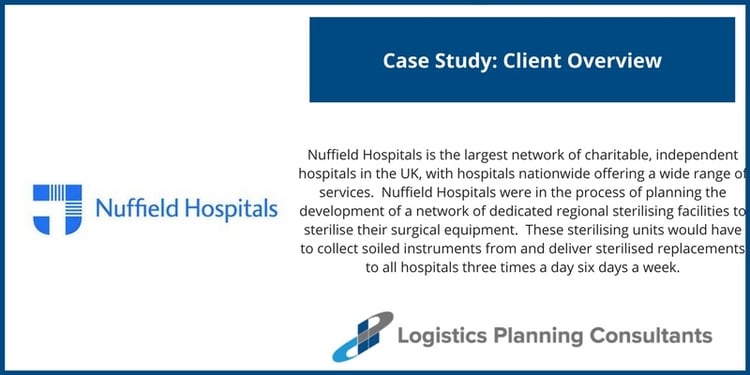
LPC was retained by Nuffield Hospitals to develop a Dips model which is a purpose-developed computer model which is very widely used for Facilities Location modelling and Transport Planning. It uses actual road networks, and can “self-optimise” location solutions as well as being used for the development and evaluation of optional scenarios. When being used for Location Modelling Dips can work either with individual collection and delivery points or with “clusters” of collection and delivery points.
 The undertaking was to:
The undertaking was to:
- Model their initial proposed solution of six units and determine their optimum locations.
- Test the effect of reallocating borderline hospitals between units.
- Carry out sensitivity testing for five and seven unit alternative solutions
- Design the collection / delivery routes for all centres within a number of restrictions.
- Determine the fleet profile for each unit.
- Produce a detailed vehicle specification.
- Benchmark available suitable locations for each regional unit against each other.
Nuffield’s main two restrictions when planning Nuffield’s solution were:
- The need for soiled instruments not to spend more than two hours on the road whilst returning to the sterilising unit – this can be relaxed somewhat with the use of appropriate chemicals.
- Narrow windows within which vehicles have to collect and deliver: 06:00~08:00, 13:00~15:00 and 19:00~21:00. The first and last visits of all routes had to fall within these windows.
Findings
Sterilising Unit Location
- The best location for a sterilising unit is not its area’s centre of gravity but in the vicinity of one of its hospitals. This is because a separate vehicle and route would not be necessary for the closest hospital; one of the existing vehicles could be double tripped. This counterintuitive result is attributable to Nuffield’s two hour window service level constraints.
- Because of the narrow delivery windows, unit location did not affect the route structure, only the route distances. Therefore the transport cost of each suitable site depended on its distance from the area’s centre of gravity. Many sites were tested for each unit.
Number of Sterilising Units in Network
- A seven sterilising unit network proved to be cheaper from a transport point of view than a six or five unit network. However, the savings in transport costs for this alternative were small compared to the high cost of an extra sterilising unit in the network, rendering this alternative strategy unsatisfactory.
Fleet Size, Profile and Specification
- The optimum fleet number and profile was determined for each sterilising unit.
- Detailed vehicle specifications were prepared for Nuffield to go to tender with.


